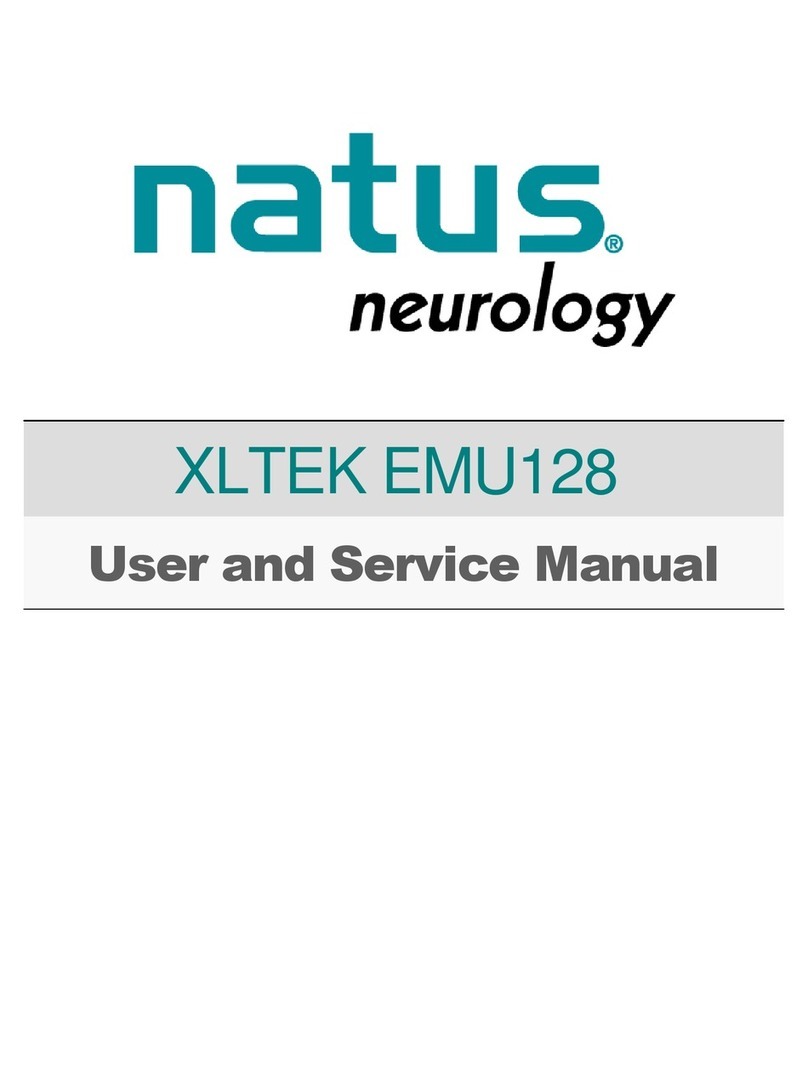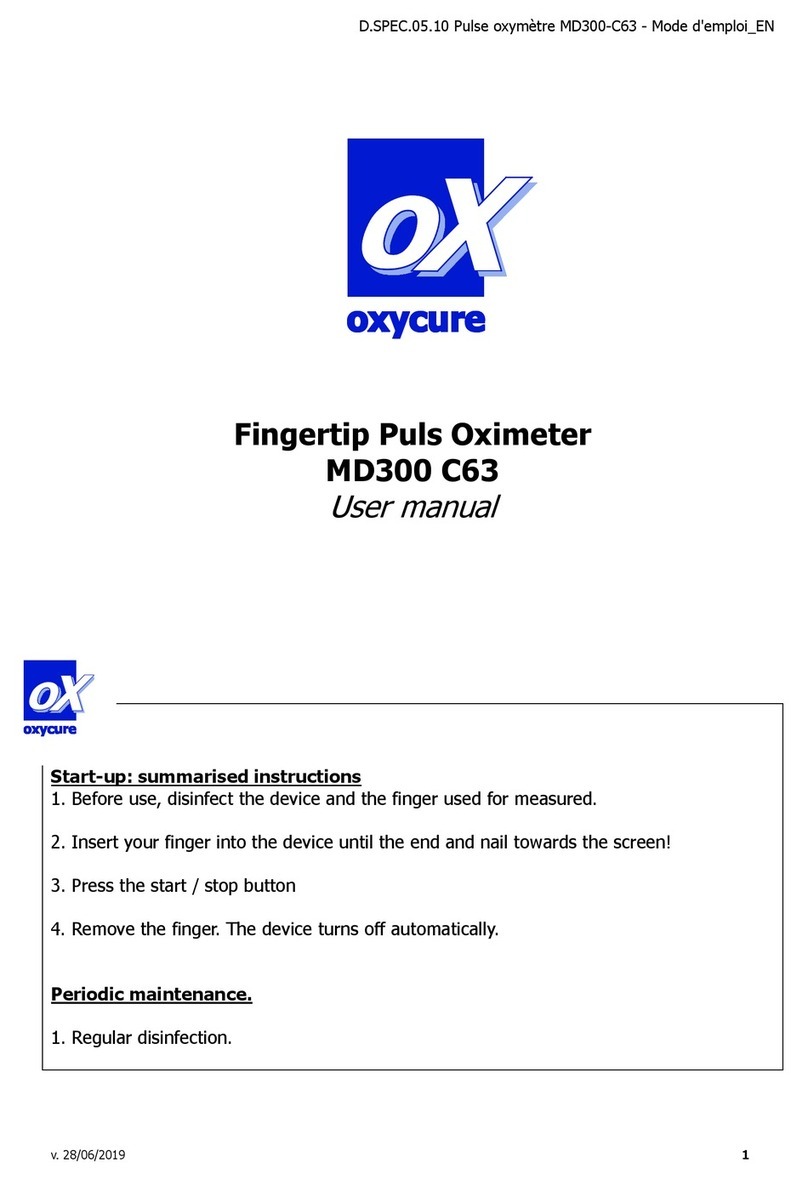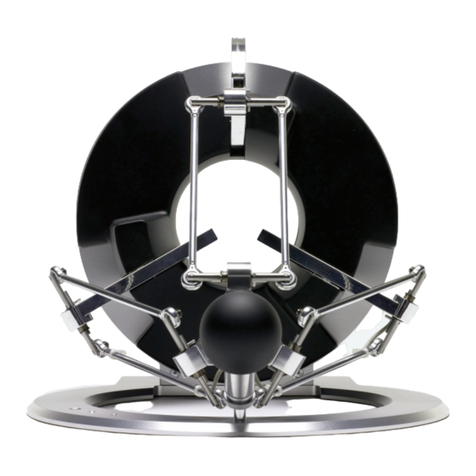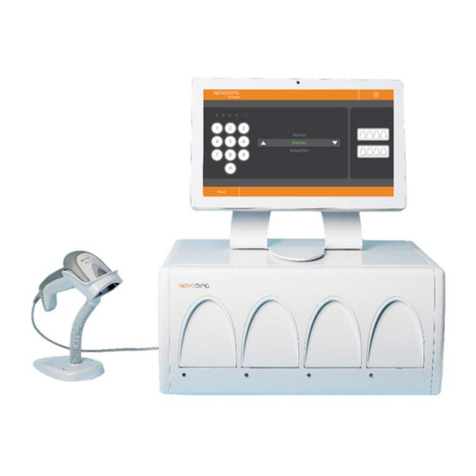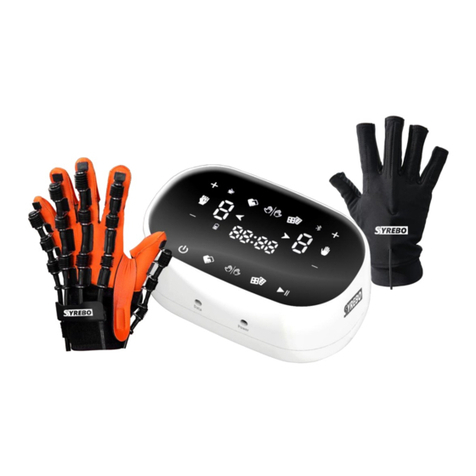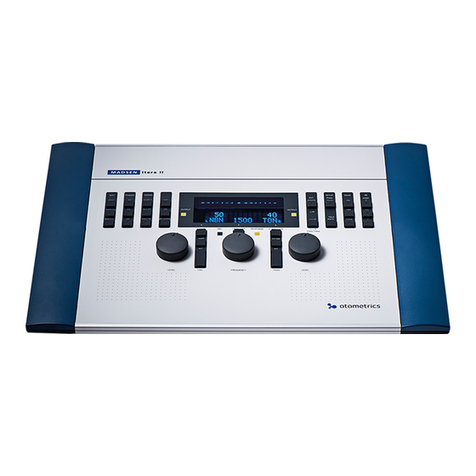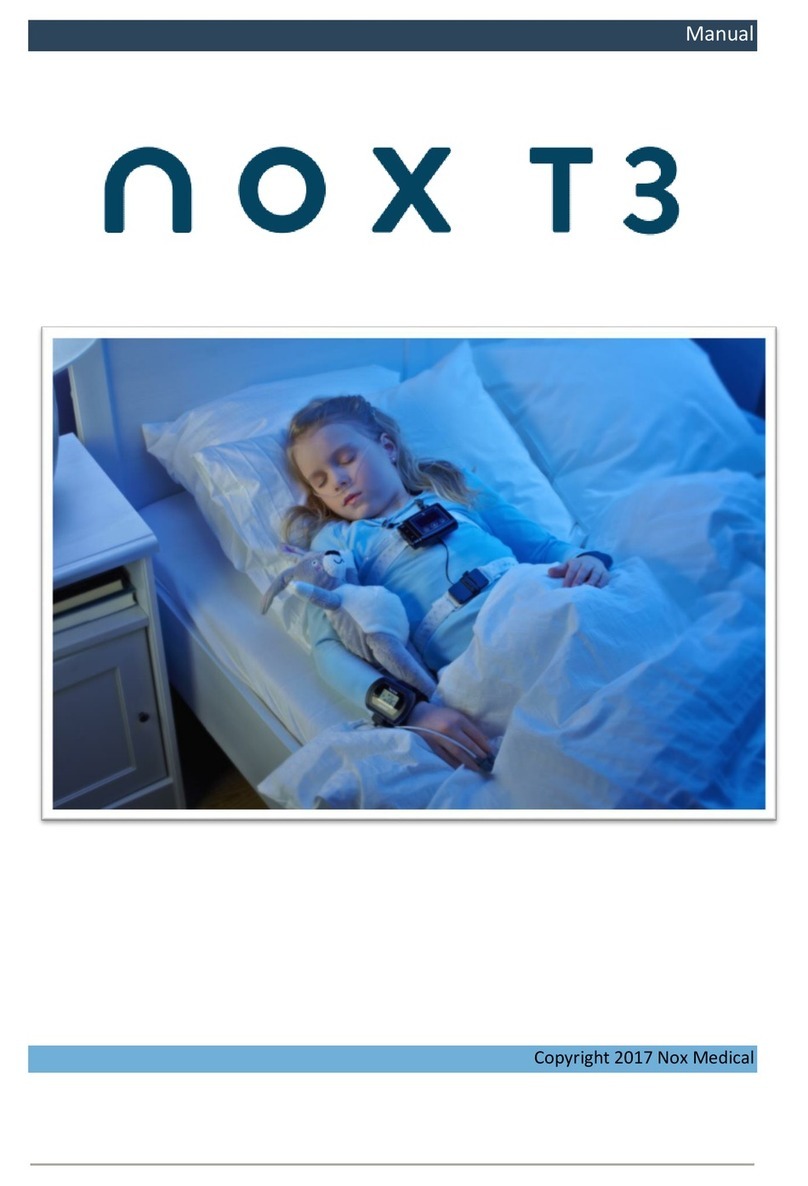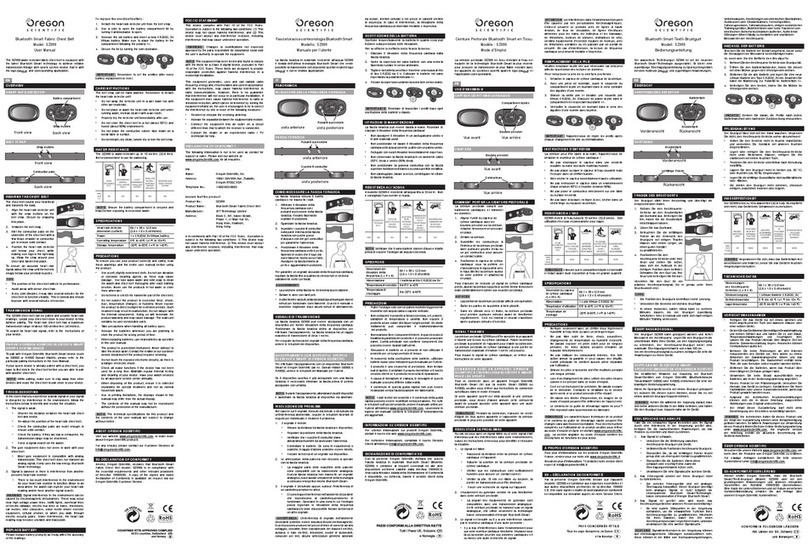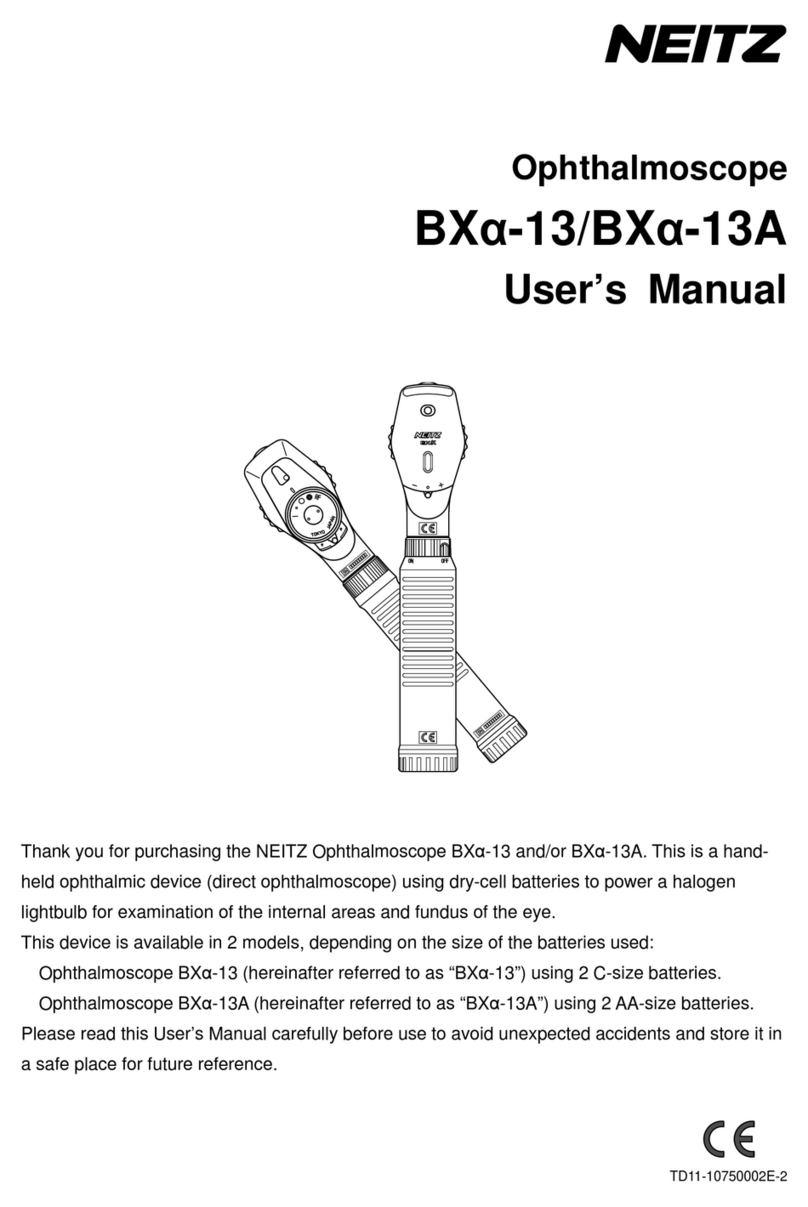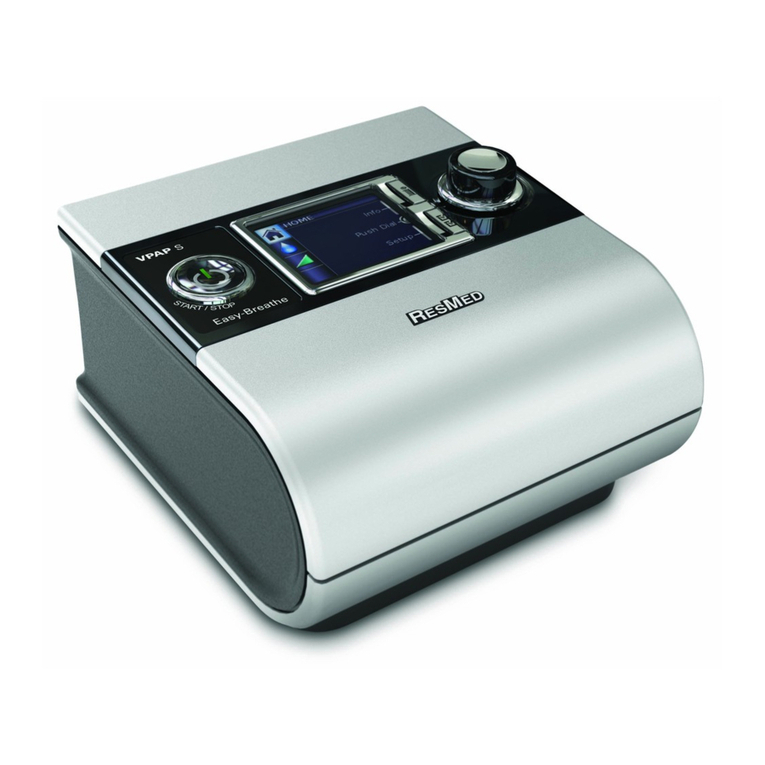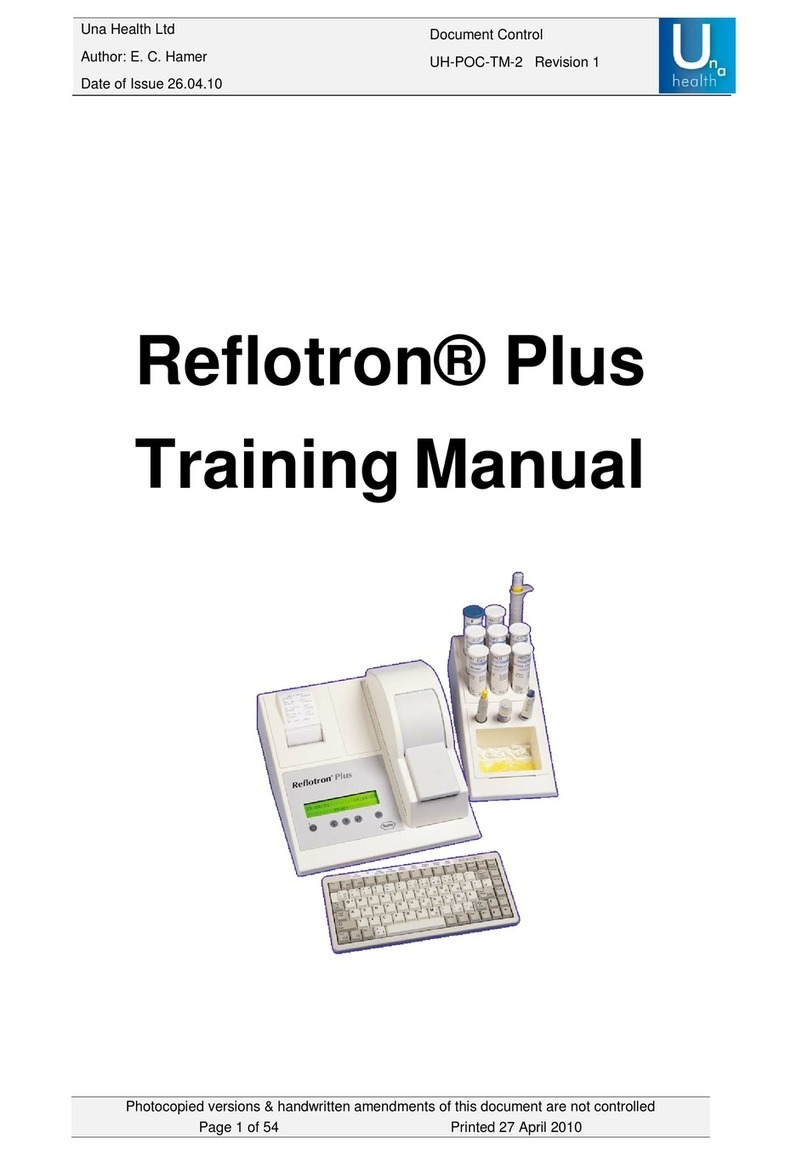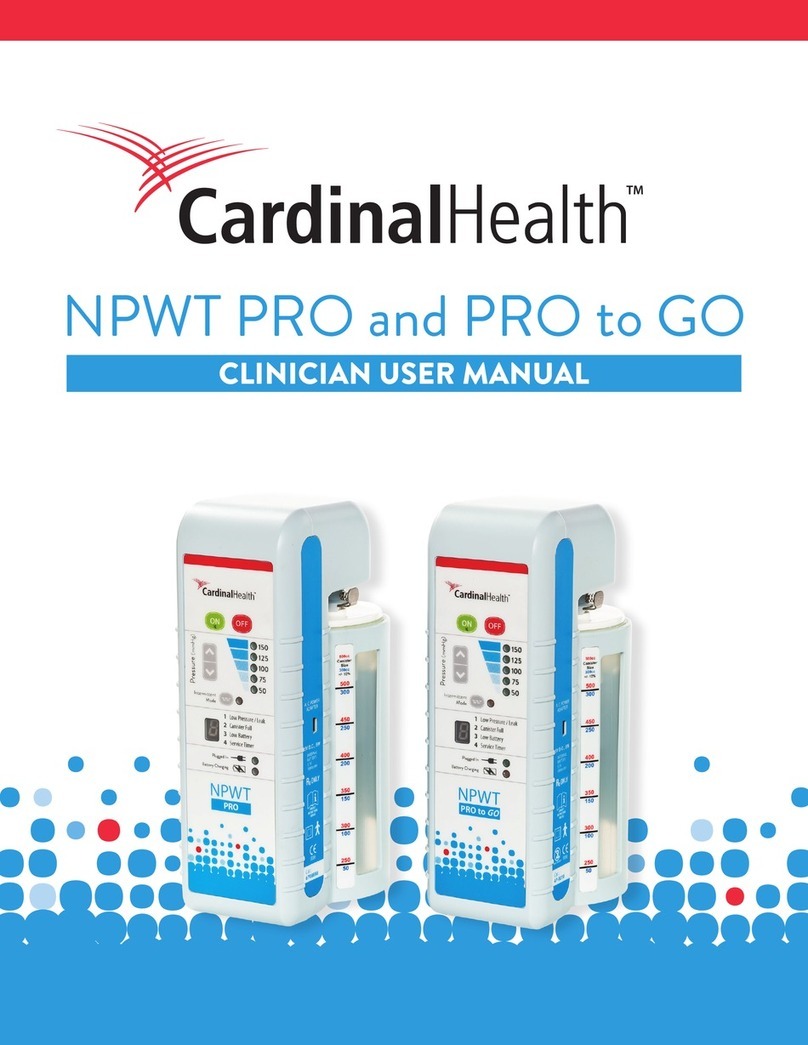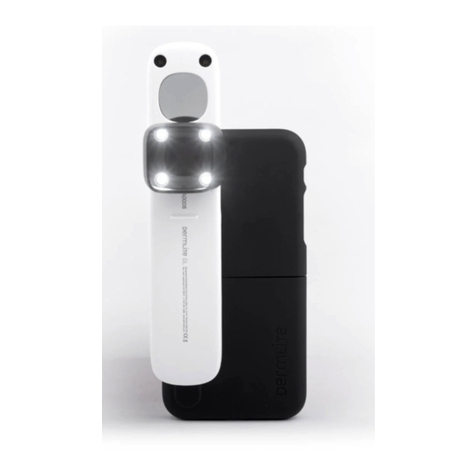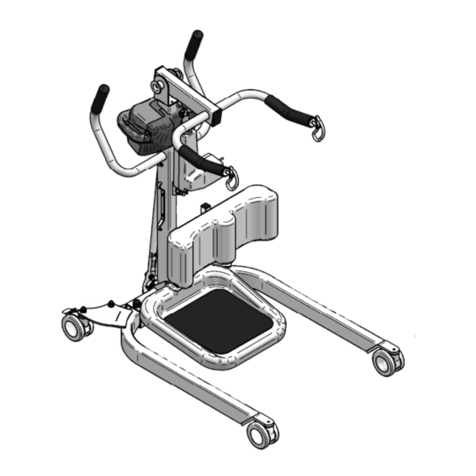GPI Umana T1 User manual

umanamedical.com
User Manual –Version 7

umanamedical.com
Page 2 of 27
Table of Contents
1. Intended Use..................................................................................................................................................3
2. Safety Information..........................................................................................................................................3
3. Regulatory Information...................................................................................................................................3
4. Advice & Safety Warnings..............................................................................................................................5
5. Contents of the Box........................................................................................................................................7
6. Contents of the Box........................................................................................................................................7
7. Labels.............................................................................................................................................................8
8. Operations Instructions...................................................................................................................................9
8.1. Preparing the T1 Heart Monitor................................................................................................................10
8.2. Preparing Patient for the SmarterSkin or SmarterSkin+ Sensor Placement ............................................10
8.3. Application of SmarterSkin or SmarterSkin+ Sensor................................................................................10
8.4. Application of the Umana T1 Heart Monitor.............................................................................................11
8.5. System Set-up .........................................................................................................................................11
8.6. Holter Mode .............................................................................................................................................12
8.7. Monitoring Mode......................................................................................................................................13
8.7.1 First time use................................................................................................................................................13
8.7.2 Normal Use..................................................................................................................................................13
9. Extension......................................................................................................................................................14
10. T1 Tempo Dongle....................................................................................................................................14
11. Maintenance and Servicing......................................................................................................................15
12. Continuous Support .................................................................................................................................16
13. Technical Specifications...........................................................................................................................17
14. Symbols Used..........................................................................................................................................20
15. EMC Information......................................................................................................................................23
16. Change Record........................................................................................................................................26

umanamedical.com
Page 3 of 27
1. Intended Use
Umana T1 Heart Monitor UMT-T1; The Umana T1 Heart Monitor is an active medical device for diagnostic ECG data collection
and analysis. It consists of the T1 Heart Monitor which uses Umana Medical’s T1 SmarterSkin and SmarterSkin Plus sensors for
gathering heart activity data. Data is transmitted via Bluetooth to its accessory T1 Monitor App installed on a third-party
smartphone or tablet. The T1 Heart Monitor and App can be used at home or in a clinical setting. The app enables either Holter
session recording or real-time monitoring with an optional extension device for longer sessions. The app transfers the ECG data
to the dashboards which can then be downloaded and analyzed in the accessory software T1 Biosignals Studio by medical
professionals. The device also presents non-diagnostic data to the medical professional as supporting information. This includes
Long-term Heart Rate, ECG-derived Respiratory Rate, Systolic Blood Pressure and Physical Activity with Fall Detection recorded
by an onboard accelerometer. This data is synchronized with the diagnostic ECG data. The T1 system can be used to either
monitor cardiac patients or healthy individuals, both males and females, from the age of 10 upwards.
Umana T1 Heart Monitor Application UMT-T1App; The T1 Monitor Application is an accessory standalone software for third-
party devices which receives and displays data transmitted via Bluetooth from the Umana T1 Heart Monitor. The application can
operate in either ‘Monitoring Mode,’ where it processes ECG data in real-time and presents it to the user on screen together with
ECG-derived long-term heart rate and respiratory rate, and physical activity data for viewing purposes only, or in ‘Holter Mode,’
which is accessed by a qualified technician to connect and activate the monitor as a Holter device and retrieve the raw ECG data
from the monitor after the prescribed monitoring session. The application uploads the ECG data file to the dashboards
automatically when the smartphone or tablet is connected to the internet. This data can be opened and studied by medical
professionals in the T1 Biosignals Studio software.
Umana T1 Biosignals Studio UMT-T1Biosig; The Biosignals Studio is an accessory standalone PC software intended for use
by medical professionals for viewing the .uma diagnostic ECG file collected through the T1 Heart Monitor. In the Biosignals Studio,
all the diagnostic ECG data is filtered and automatically analyzed for detecting abnormalities. The non-diagnostic ECG-derived
Respiration Rate and Systolic Blood Pressure data as well as the Physical Activity data gathered are time stamped and
synchronized with the ECG reading so that they can provide further information to the medical professional. The ECG data and
report can be used by medical professionals to make diagnosis and make informed decisions about patient treatment.
Umana Tempo UMT-T1Tempo; The Umana T1 Tempo dongle is a medical device accessory that connects to the Umana T1
Heart Monitor port. Its function is to measure the oxygen saturation of a user’s blood and body temperature, and transmits it via
Bluetooth to the Umana T1 App.
2. Safety Information
•The Umana T1 Heart Monitor is a Class IIA device according to the classification in the Council Directive 93/42/EEC for medical
devices. the device is intended for continuous use. It conforms to the following Standards and Directives:
•
Directive 93/42/EEC for medical devices, with amendments by 2007/47/EC
•
Medical Devices Regulation (EU) 2017/745
•Subsidiary Legislation 427.44,
Malta –Medical Devices regulation Legal Notice 210 of 2008, as amended by Legal Notice
320 of 2020,
•
ISO 13485
•
EN 60601–1
•
EN 60601-1-2
•
EN 60601-1-11
•
EN 60601-2-25
•EN 60601-2-47
•Radio Equipment Directive(2014/53/EU)
This product user quick guide and this user manual are available in several languages
3. Regulatory Information
Brand: Umana T1 Heart Monitor
Manufacturer: Umana Building, St. Thomas Street, Luqa, LQA 9033, Malta, EU.
Email: [email protected]

umanamedical.com
Page 4 of 27
The device and its software accessories, collectively referred to as ‘Umana T1 Heart Monitor’ are identified with
Product/ Accessory
1. Technical Name
2. Brand Name
Product ID
Code
Design
Variant
code
Intended Use
Classification
1. Umana T1 Heart
Monitor
2. T1 Heart Monitor
UMT-T1
(UMT-T1)02
The Umana T1 Heart Monitor is an active medical
device for diagnostic ECG data collection and
analysis. It consists of the T1 Heart Monitor which
uses Umana Medical’s T1 SmarterSkin and
SmarterSkin Plus Sensors for gathering heart
activity data. Data is transmitted via Bluetooth to its
accessory T1 Monitor App installed on a third-party
smartphone or tablet. The T1 Heart Monitor and App
can be used at home or in a clinical setting. The App
enables either Holter session recording or real-time
Monitoring with an optional extension device for
longer sessions. The App transfers the ECG data to
the dashboards which can then be downloaded and
analyzed in the accessory software T1 Biosignals
Studio by medical professionals. The device also
presents non-diagnostic data to the medical
professional as supporting information. This
includes Long-term Heart Rate, ECG-derived
Respiratory Rate, Systolic Blood Pressure and
Physical Activity with Fall Detection recorded by an
onboard accelerometer. This data is synchronized
with the diagnostic ECG data.The T1 system can be
used to either monitor cardiac patients or healthy
individuals, both males and females, from the age of
10 upwards.
Class IIa, Rule
10
1. Umana T1 Heart
Monitor Application
2. T1 Monitor App
UMT-
T1App
(UMT-
T1App)
The T1 Monitor Application is an accessory
standalone software for third-party devices which
receives and displays data transmitted via Bluetooth
from the Umana T1 Heart Monitor. The application
can operate in either ‘Monitoring Mode,’ where it
processes ECG data in real-time and presents it to
the user on screen together with ECG-derived long-
term heart rate and respiratory rate, and physical
activity data for viewing purposes only, or in ‘Holter
Mode,’ which is accessed by a qualified technician
to connect and activate the monitor as a Holter
device and retrieve the raw ECG data from the
monitor after the prescribed monitoring session. The
application uploads the ECG data file to the web
application automatically when the smartphone or
tablet is connected to the internet. This data can be
opened and studied by medical professionals in the
T1 Biosignals Studio software.
Class IIa, Rule
10
1. Umana T1 Tempo
Dongle
2. T1 Tempo Dongle
UMT-
T1Tempo
(UMT-
T1Tempo)
The Umana Tempo dongle is a medical device
accessory that connects to the Umana T1 Heart
Monitor port. Its function is to measure the oxygen
saturation of a user’s blood and body temperature,
and transmits it via Bluetooth to the T1 Umana
Biosignals Web Application.
Class IIa, Rule
10
1. Biosignals Studio
2. T1 Biosignals Studio
UMT-
T1Biosig
(UMT-
T1Biosig)
The Biosignals Studio is an accessory standalone
PC software intended for use by medical
professionals for viewing the . uma diagnostic ECG
file collected through the T1 Heart Monitor. In the
Biosignals Studio, all the diagnostic ECG data is
filtered and automatically analyzed for detecting
abnormalities. The non-diagnostic ECG-derived
Respiration Rate and Systolic Blood Pressure data
as well as the Physical Activity data gathered are
time stamped and synchronized with the ECG
Class IIa, Rule
10

umanamedical.com
Page 5 of 27
reading so that they can provide further information
to the medical professional. The ECG data and
reportcan beusedbymedicalprofessionalstomake
diagnosis and make informed decisions about
patient treatment.
4. Advice & Safety Warnings
Each Umana T1 Heart Monitor system should ideally be used by one user to avoid the possibility of skin-related infection. Where
this is not the case, be sure to follow the cleaning and disinfection instructions in this manual.
People with pacemakers or other heart implants (ICD/CRT devices) should not use the Umana T1 Heart Monitor.
General operation of the device may be affected by the use of an electrosurgical unit (ESU). This device should not be used
adjacent to other equipment. If adjacent use is necessary, the device should be observed carefully to verify normal operation.
We suggest not to use device on children under 10 years old. Children and elderly people should be assisted when applying the
sensors and the device and connecting to the application due to mobility difficulties.
WARNING: The device is not intended to be used in emergency situations and is not an alarm device intended to prevent
immediate danger to the patient.
The Umana T1 cannot be used to call emergency numbers including 112.
In emergency or critical situations where, immediate real-time diagnosis is necessary, such as in an ambulance, when using a
defibrillator, or during electrosurgery, the Umana T1 Monitor should be removed.
The data viewed in the app or on the dashboards is for viewing purposes only. The abnormalities detected in the ECG are
suggestions for the medical professional. The Biosignals Studio does not give diagnosis automatically but indicates potential
suggested abnormalities which the doctor can view and analyse to decide if further actions or tests need to be taken. Only the
ECG data is diagnostic.
Other vital signs presented including Average Heart Rate, Respiration Rate and Systolic Blood Pressure are not diagnostic since
they are extracted from ECG through algorithmic calculations. This applies also to the Physical Activity and Fall detection data.
These vital signs are presented only as additional information for the medical professional, synchronized in time to the ECG.
Home use patients and their careers using the Monitoring Mode application should keep in mind that the indicated abnormalities
are suggestions which must be shared with a medical professional to take any treatment or diagnostic actions.
Clean the T1 Heart Monitor regularly as described in this document. If it is used by more than one person, disinfection is also
necessary.
Clean the area where the sensor and the T1 Heart Monitor will be applied by shaving and cleaning the area from dust, sweat and
dead skin cells using alcohol wipes. It is a known fact that shaving, or waxing can cause irritation if damaged or low-quality blades
or material are used. If the area that has been shaved, or waxed, appears to be irritated or sore, allow some time before cleaning
with alcohol wipes and applying the sensors.
Do not let water fall on the T1 Heart Monitor, including sweat if possible. Remove the monitor before showering, bathing, or
swimming.
Use only the charger provided to charge the device. Other commercially available adapters may not meet the safety requirements
for the use with medical devices.
The port on the monitor is only to be used for charging the device using the provided charger.
WARNING: Do not use the T1 Heart Monitor while charging. As a safety feature, this device does not work while charging
as an internal system prevents this.
While charging the power outlet where the charger is inserted must be easily accessible
Charging should not be carried out by children, especially if unsupervised, to avoid the possibility of strangulation due to
the adaptor’s cable.
The duration of a monitoring session should be discussed with your medical professional to make sure that enough data is
recordedforanalysis. Durationishoweverlimited to 24 continuous hours due to battery life and the sensor must be replaced
after 3 to 5 days.
ItisimperativethattheUmanaT1HeartMonitorisusedwiththeUmanaT1SmarterSkin sensors.
When a pop-up appears requesting that you connect the T1 Heart Monitor properly, check that all the connection ports are
making good contact with the corresponding ports on the sensors.
Ensure that your software is up to date. Umana Medical may issue software updates to improve the performance of the
system and to introduce new features.
WARNING: No modification of this equipment is allowed. Warranty is forfeited if device is tampered with.
The battery cannot be changed or replaced except by the manufacturer.
Do not point sprays or nebulizers at the device; keep the device clear of these substances.
Keep device away from sources of heat or open flames. This includes outdoor activities that can lead to excessive sweating
or heat.
Electromagnetic interference while the device is in use might affect other electrical equipment, such as radios, Bluetooth –
connected devices, etc.
Electromagnetic interference from other electrical equipment might interfere with the functioning of the monitor. While no
RF equipment disturbances have been notified whilst using devices up till a frequency of 5GHz near the device, it is advised
that any Radio Frequency (RF) equipment of this
frequency or higher should be kept at 2 meters.

umanamedical.com
Page 6 of 27
The sensor is not compatible with X-ray scan, Computed Tomography and Magnetic Resonance Imaging as it integrates non
removable metal parts.
Keep device away from children and pets when not in use to minimize the risk
of mechanical damage due to mishandling. The
sensors should not be left in reach of children or animals so as not to be placed in the mouth. The sensor pouch must be
cut open only when the sensor is to be used immediately.
Ensure that the device is only switched on when the Umana T1 Heart Monitor is already placedonthechest oftheuser.
If the person who will be wearing the sensor has sensitive skin or is aware of any causes of allergy or irritation to his or her
skin, they should consult their doctor before purchasing the Umana T1 system. The materials chosen to make the sensors
have been selected specifically for their common use in skin applications for normal skin and do not harm the dermal layers.
If you experience any irritation, burning or severe redness, apply baby oil to the sensor and remove immediately. Your
doctor should be consulted as this might be due to an allergy you were not aware of.
The Umana T1 sensors should only be applied to intact undamaged skin which has been thoroughly cleaned with the
provided wipe and dried off.
To remove the sensors, apply a generous amount of baby oil to the sensor, rub gently and pull away the sensor from the
edge of the protective film. If any redness appears after removing the sensor, this is a very normal reaction and should
disappear quickly. Cleaning with alcohol wipes and applying smoothing cream can also help.
Adult supervision is required when using charger near children.
If at any point Bluetooth connection stops between the device and smartphone/tablet, a notification will appear on the screen
asking you to reconnect the T1 device. If the T1 device does not appear in the smartphone/tablet`s list of BT available
devices within range, switch off and on both the monitor device and the application. This can be caused by slight
electromagnetic disturbances.
Patients with known intolerance with acrylic adhesive should not use SmarterSkin sensors.
Patients with known intolerance with nickel should not use the UMANA T1Tempo Dongle.
The Umana TEMPO Dongle should not be applied on tattooed areas as this could interfere with the infrared light used by the
SpO2.
Patients with excessive dry skin should not utilise this device since it may interfere with the readings.
Patients with suspected allergies to medical adhesives should consult their health care professional before using the SmarterSkin
/Smarterskin+ sensors.
Do not make fundamental changes in your treatment program without talking to your health care team. Serious illness or accidents
may result.
In case of several continuous measurements that are considered to be abnormal, the device will notify you as a suggestion to
consult your healthcare professional.
Do not make therapy treatment decisions based on the Umana T1 heart monitor.
Follow the instructions for the placement and disposal of the Umana SmarterSkin/SmarterSkin+ sensors.
The SmarterSkin/SmarterSkin+ sensors should not be applied on tattooed areas.
Latex is not part of the materials used to create the sensor; however, it is not guaranteed that contamination does not happen
during the manufacturing/packaging process.
Patients with excessive dry skin should not utilise this device since it may interfere with the readings.
Keep away all the contents from children due to the risk of swallowing small parts.
The behaviour of the Umana T1 Tempo Dongle has not been tested under motion and for this reason, when the Umana T1 Heart
Monitor is utilised with the Umana T1 Tempo dongle, movement should be limited entirely, and patient should be at rest.
The Umana T1 Tempo Dongle has not been tested for low perfusion conditions.
Ensure that a minimum of 30 minutes warm up to measure the temperature using the Umana T1 Tempo Dongle
Do not use with patients with tremors or convulsions.
Diseases with peripheral circulatory disturbance may cause incorrect readings of the SpO2 measurement through the Umana T1
Tempo Dongle
The Umana T1 tempo Dongle cannot be utilised in critical conditions.
The device is designed to determine the percentage of arterial oxygen saturation of functional hemoglobin. Factors that may
degrade pulse oximeter performance or affect the accuracy of the measurement include the following: Device not applied correctly,
Excessive motion, Methaemoglobin and Intravascular dyes
Do not install applications that may contain malware.
Do not leave smartphone unattended and unlocked.
Use security measures to lock smartphone when not in use.

umanamedical.com
Page 7 of 27
5. Contents of the Box
The Umana T1 Heart Monitor Starter Pack
consists of the following:
•Umana T1 Heart Monitor (UMT-T102)
•Quick Guide for quick start and daily usage
reference that includes a link
to access this detailed user manual
•
Charger Adapter for the Umana T1 Heart Monitor
•
Battery Charger
*T1 Tempo Dongle is a medical device accessory and is not found within the starter pack but may be purchased in the
T1 Tempo Dongle Pack.
6. Contents of the Box
A. Sensors
•Sensors printed with conductive ink on Polyurethane adhesive substrate.
•Type CF applied part.
•Picks up physiological readings from the user to the device.
•Three stud connectors.
•Protective film supplied with each sensor.
•Each sensor and protective film are supplied in a sealed pouch.
B. Battery in Monitor Case.
•One button battery per T1 Heart Monitor.
•Rechargeable, not removable, or replaceable.
•To be charged only by provided charger.
C. Monitor Case
•On/Off button; also, Notification button in Holter Mode.
•Port for charging with supplied Medical approved battery charger.
•2 ports for dongle attachments
•Three socket connectors on the back
•Enclosures of the Umana T1 Heart Monitor are protected against the ingress of solid foreign objects of 1mm diameter and
greater and are protected against water projected by a nozzle (diameter 6.3mm) at a distance of 2.5-3m. classification of Ingress
Protection is IP45.

umanamedical.com
Page 8 of 27
Monitor Mode
Flashing Green
Holter Mode
Flashes Green every 10s
BLE not connected
Flashing Blue
BLE connected
Solid Blue
Lead off detect
Solid Red
Charging
Solid Red
Low Battery
Flashing Red
7. Labels
Starter Pack:
Sensor Packs:
Software Accessories:
•Smartphone/Tablet application operable in Monitoring Mode and Holter Mode
•Biosignals Studio software
•The real-time Monitoring Mode of the application and the offline Biosignal Studio use identical algorithms for processing ECG
signal and representing other vital signs data.
These include algorithms for:
•Filtering the ECG
•Detecting ECG abnormalities
•Extracting Respiration Rate from ECG
•Calculating Systolic Blood Pressure

umanamedical.com
Page 9 of 27
•Calculating Physical Activity from accelerometric data
•Detecting Falls
•Measuring Function: Calculating Sp0₂(optional using T1 Tempo Dongle)
•Measuring Function: Body Temperature (optional using T1 Tempo Dongle)
The data viewed in the app or on the dashboards are for viewing purposes only. The abnormalities detected in the ECG are
suggestions for the medical professional. The Biosignals Studio does not give diagnosis automatically but indicates potential
suggested abnormalities which the doctor can view and analyze to decide if further actions or tests need to be taken. Only the
ECG data is diagnostic. The other vital signs are not since they are extracted from ECG through algorithmic calculations and are
presented only as additional information, synchronized in time to the ECG. The smartphone app and the Biosignals Studio are
accessories and stand-alone software because they drive a device or influence the use of a device and as such, they fall
automatically in the same class of the medical device they influence, which is the Class IIa Umana T1 Heart Monitor.
Hardware Accessories:
•Offload Dock Transfer data from Device storage to Device (to be used in Holter mode only).
•T1 Tempo Dongle: Measures the oxygen saturation of a patient’s blood (to be used in Monitor mode only) and Body
Temperature and is considered as a medical device accessory for the Umana T1 Heart Monitor with a measuring function.
•T1 Heart Monitor Extension: This is marketed as an Extension Pack as it is essentially a clone or a slave of the master Umana
T1 Heart monitor that is provided within the Starter Pack. The clinicians may make use of this device to increase the monitoring
durations.
8. Operations Instructions
•Turn off and inspect T1 Heart Monitor to ensure that it is free from any damage, including cracks.
•Clean T1 Heart Monitor by wiping the surface thoroughly with disposable, clean, lint-free cloth impregnated with cleaning agent.
•Repeat step 2 using disinfecting agent.
•Ensure moisture does not enter critical areas of device (i.e., ports).
•Air-dry or hand-dry using a disposable, clean, lint-free cloth.
For single-patient use, it is recommended to clean and disinfect T1 Heart Monitor on a regular basis. For multiple-patient
use, it is mandatory to clean and disinfect T1 Heart Monitor prior to every session.
•Disinfectants containing Mercury, Phenols, Bromine, Iodine, Zinc, Tin and organo-metallic compounds should be avoided.
•
•Do not use steam sterilization as the cable insulation might not withstand the heat.
•
•It is very important that no water/cleaning agent/alcohol enters the device case. Ensure that the cloth being used is only
slightly wet to minimize the risk of the cleaning agent flowing into the device.
•
•The use of the incorrect solution concentrations or the immersion of a transducer to a greater depth or for a longer period
than indicated in the instructions could damage the device.
•
•Always use any protective goggles and gloves as indicated on the product when cleaning and disinfecting of any device or
equipment.
•
•If using a premixed solution, always respect the “USE BY” date of the disinfectant.

umanamedical.com
Page 10 of 27
8.1. Preparing the T1 Heart Monitor
•Charge the T1 Heart Monitor for 4 hours using the provided charger and charging adapter only. Connect the charger to the
adapter, then connect the adapter to the middle magnetic connector of the T1 Heart Monitor. Ensure corrected orientation
accordingly to the plastic notch in the adapter. Ensure that the battery charger is switched ON from the mains supply.
•To turn T1 Heart Monitor ON, press the power button located on back of device.
•To turn T1 Heart Monitor OFF, press and hold for 3 seconds the power button located on back of device.
To conserve battery life, turn T1 Heart Monitor ON only at the point of connecting to T1 App. Keep T1 Heart Monitor ON
for the whole duration of the Holter or Monitoring Sessions. The T1 Heart Monitor becomes inactive while charging, as
a safety feature.
8.2. Preparing Patient for the SmarterSkin or SmarterSkin+ Sensor Placement
•Maintain good infection control practice by washing hands prior to patient contact.
•Patients with chest hair should have hair at placement site removed, ideally not less than 4 hours before.
Tear open the sealed silver pouch containing the sensor, protective film and wipe. Clean placement site with the alcohol wipe
provided and leave to dry.
Apply SmarterSkinTM Sensor on intact clean dry skin only. Abrasive
pastes specifically manufactured for ECG tests may be used to rub on
the skin to increase sensor adherence and remove unwanted dead skin
cells. Such pastes help reduce skin impedance for improved quality of
recordings. Ensure product compatibility with patient prior to use. Ensure
no abrasions are caused. If the skin is oily or the patient applied any
creams or lotions, use a wipe or abrasive paste to clean placement site.
Ensure product compatibility with patient prior to use.
8.3. Application of SmarterSkin or SmarterSkin+ Sensor
•Sensors are provided in various packs i.e., Getting Started packs (SmarterSkin or SmarterSkin+ Sensors) and Sensor Packs
(SmarterSkin or SmarterSkin+ sensors)
•Tear open the sealed silver pouch containing the SmarterSkin™ / SmarterSkin+™ Sensor and Protective Film.
•Remove backing liners from SmarterSkin™ / SmarterSkin+™ Sensor, following their arrow instructions to expose adhesive side.
•Place adhesive side of SmarterSkin™ / SmarterSkin+™ Sensor onto patient’s left side in the third intercostal space
perpendicular to the midclavicular line.
•Ensure that SmarterSkin™ / SmarterSkin+™ Sensor is placed with the 3 snaps creating a V shape, and the middle electrode
as vertically straight as possible.
•Ensure no air bubbles are trapped between SmarterSkin™ / SmarterSkin+™ Sensor and skin.
•Remove backing liners from Protective Film to expose adhesive side.
•Place adhesive side of Protective Film over SmarterSkin™ / SmarterSkin+™ Sensor.
•Ensure punched holes lie directly over the 3 snaps found on the SmarterSkin™ Sensor, leaving them exposed. Also
ensure that the alignment is correct such that the other holes are not covered to avoid issues during use of the T1
monitor and its accessories.

umanamedical.com
Page 11 of 27
Placement Site:
Place SmarterSkinTM / SmarterSkin+TM sensor onto patient’s left side in the third intercostal space perpendicular to the
midclavicular line.
8.4. Application of the Umana T1 Heart Monitor
•Take the Umana T1 Heart monitor out of the packaging.
•Clip the Umana T1 Heart monitor with the stud connector sockets on the corresponding studs of the sensor.
•Switch on the UmanaT1 Heart Monitor by pressing the push button. (Refer to LED section in this manual)
Fully charge T1 Heart Monitor using the Battery Charger and Charger adapter provided.
8.5. System Set-up
Select mobile device to be used to connect with the T1 Heart
Monitor. Ensure adequate internet connection and turn Bluetooth
& Location ON. Download the Umana T1 Heart Monitor
Application Accept all requested permissions required for the
application to run.
For first time use, contact your local distributor for an Account or

umanamedical.com
Page 12 of 27
8.6. Holter Mode
For the first time use, contact your local distributer for an Account or send an email to [email protected]
1. Log in (Internet
connection is required for
account verification).
2. Enter the patient
code/ID and tap “Next”
3. In the ‘File Manager’
tap ‘Find the Bluetooth
Device’ and select your
device which is
identified by its serial
number
4. Choose your sensor,
SmarterSkin or
SmarterSkin+ (refer
to sensor packaging)
5. Tap ‘Test Monitor` and
confirm signal on ECG
plot
6. Check that all statuses
are `Connected` and
battery of device is full
before you start a
session.
7. Tap ‘Start Holter’ to start
a Holter session. Tap
‘Stop Monitor’, to stop the
session.
8. Connection to
Bluetooth will be
automatically
switched off and
Monitor will start
saving data in its
internal memory.
(Refer to LED section
in this manual)
Upload of Holter Session
For first time use: Refer to the T1 web application to download and install the Data Transfer Interface on a PC (internet connection
is required).

umanamedical.com
Page 13 of 27
1. Open the Data Transfer Interface software
2. Log in using the same T1 app credentials (internet connection is required)
3. Switch on T1 Heart Monitor and plug into the offload dock.
4. With the USB cable provided, connect the offload dock to a PC.
5. Click on ‘Detect’ and wait until the T1 device is detected.
6. Once the device is detected, the serial number is listed on the screen. Select the
serial number and click ‘Upload Holter Session’. (Internet connection is required)
7. Enter the patient code/ID and click ‘Next’
8. The offload process starts and wait until the process is completed successfully.
9. Switch off the T1 Heart Monitor and disconnect the offload dock from the PC.
10.Close the offload uploader
8.7. Monitoring Mode
8.7.1 First time use
1. Login using the credentials
(email and password) provided.
2. Read and Accept Terms and
Conditions.
3. Information screen to download The
User Manual. Tap ‘Next’.
8.7.2 Normal Use
1.Select your device by
serial number and press to
connect.
2. Optional you can give a
name to the connected
monitor and tap ‘Next’.
3.Choose your sensor,
SmarterSkin or
SmarterSkin+ (refer to
sensor packaging)
4. This screen will check the
system. If all is connected the
app will take you to the next
screen.

umanamedical.com
Page 14 of 27
5. In this screen you can
view the ECG signal
with other vital signs
6. If you are using the
SmarterSkin+, press on
the ECG graph and the
app will redirect you to
the 6-channel screen
9. Extension
The Extension T1 Heart Monitor is to be utilized when the other Umana T1 Heart monitor is being charged. The Extension T1 is
identified with the same UMT-T102, however it is identified with an S after each serial number. The extension can only work if you
already purchased an Umana T1 monitor.
•When monitor connected to the app is switched off
without battery, the app will notify you.
•Switch on the Extension and press Ok on the popup
notification in the app. The app will automatically connect
with the Extension.
•When the Extension is switched off without battery, the
app will notify you and you can connect the charged
master device.
•You can repeat the sequence as much as required.
Note that device not in use must be charged for 4 hrs.
10. T1 Tempo Dongle
This medical device accessory that connects to the Umana T1 Heart Monitor port. Its function is to measure the oxygen saturation
of a user’s blood and body temperature.

umanamedical.com
Page 15 of 27
1. Connect tempo dongle to the Umana
T1 Heart Monitor
2. Switch ON the monitor
3. Place the monitor on the
SmarterSkin or SmarterSkin+
Sensor. Switch on the application
and follow the instructions in the
Normal use section of this manual
11. Maintenance and Servicing
General maintenance and Troubleshooting
For the Umana T1 Heart Monitor to remain in good operable condition, it is necessary to take the following precautionary
measures:
1. Clean the Umana T1 Heart Monitor daily and disinfect as instructed.
2. Avoid mishandling of the enclosure. For this reason, it should be kept away from children and pets when not in use and stored
securely.
3. Avoid charging the batteries excessively –batteries are to be charged only when required, as indicated on software or by the
red LED light on the monitor. Batteries in the device can only be charged using the charger provided.
4. Synchronize the data regularly. This should happen automatically when an Internet connection is active, and the device is
switched on. Synchronization is important so that all your data is saved on the online server.
5. If the software application is experiencing problems such as loading and synchronization, check whether you have the latest
version of the T1 Heart Monitor application on the Google Play Store and update if it is necessary.
6. If the smartphone memory is full of data and cannot store any more recordings, synchronize the data so that it is uploaded to
the web application. A 3G or Wi-Fi connection is required.
Note: If you require assistance, need to report an issue or experience unforeseen events please contact your local
Servicing: When you encounter the following problems, contact your local distributor for servicing. If needed, you will be provided
with a temporary replacement device until yours is repaired. If the damage is not repairable, review the product warranty with your
local distributor to define next steps. Some servicing examples include:
1. If the On/Off button becomes jammed, or the LED light does not light up when the device is switched on, service repair
personnel will replace the T1 Heart Monitor with a new one.
2. If the sensors in your starter pack or sensors pack, despite being stored as instructed, do not adhere properly when applied
or their connection to T1 Heart Monitor is not constant, contact distributor for replacement or to purchase new sensors.
3. If device enclosure breaks ormonitor is not performing its functions properly, service repair personnel will replace the T1 Heart
Monitor with a new one.
4. If the battery stops charging or the device needs too frequent charging, the device should be returned to the manufacturer
through the distributor. The battery cannot be changed or replaced by anyone except than the manufacturer. If the device is
still within the warranty period it will be replaced with a new one from your distributor.
5. Before using the device, make sure the LED is not red and the battery is fully charged.

umanamedical.com
Page 16 of 27
6. Ensure that the calibration screen on the smartphone Monitor Mode app confirms that the sensor is fully connected and
therefore a good signal is being received, the Bluetooth is connected to the phone and connected to the online cloud server
using Wi-Fi or 3G/4G/5G before starting a monitoring session. If any or all these performances are not met, even after changing
sensor, charging battery, reconnecting Bluetooth or reconnecting to internet, therefore preventing the full and correct use of
the device, then contact your local distributor for a device replacement if it is still under warranty. The manufacturer will inspect
the device for any faults.
7. A distorted signal may be due to the degradation of the electrodes. The app will advise you if a good signal is not being
received. Check the label on the silver pouch containing the sensor and if it indicates a production date over than two years
prior contact distributor for replacement sensors. If sensors are still within the two-year period after production and the
electrodes are visibly degraded and signal is distorted, try another sensor. If same issue is experienced contact distributor or
manufacturer who will provide you with replacement sensors and inspect the problem.
The Umana T1 Heart Monitor should only be serviced by trained personnel appointed by the manufacturer. Contact your local
distributor for more information. Service personnel are provided with all technical data needed for proper servicing and
maintenance, upon request. Terms of payment for repair and replacement depend on the warranty.
Life Expectancy: The lifetime of the Umana T1 Monitors is determined by the lifetime of the battery which amounts to 500
complete cycles of charging and discharging. Depending on whether the device is used by one person or more such as in a clinic,
occasionally or daily, for short periods or long periods such as 24hr Holter Mode, and depending on the correct usage, storage
and maintenance of the product as per user instructions the number of years of how long the monitor will be functional will vary.
If the device is used correctly and regularly it should last around 2 years. T1 Heart Monitors that have not been used for a while
should ideally be charged every 6 months. When using the device for the first time it is recommended to charge it fully before use.
The smartphone/tablet software monitoring application and the Biosignals Studio software lifetime is to depend on the number of
versions that are released. Typically, a newversion of the software is released every year, denoted by theversion number change
in the first digit: V.n.0.0. New and improved features denoted by the second digit: V.0.n.0 and minor bug fixes denoted by the third
digit: V.0.0.n are ideally grouped per quarter, or four times a year. This is unless improving features and bug fixes are urgent,
such as in cases where users cannot make proper use of the application and therefore the device, which in such a case would
need an urgent release within not longer than a month. On Google Play, it is possible to automatically update your application
with new uploaded releases without involving the user’s intervention. The PCB firmware lifetime can be considered to coincide
with the need for implementing improvements and new features, alsoversion controlled in the format of Vn.n.n. These are typically
restrained to an update every 6 months if needed. At the early stages of market entry, as feedback from device usage is gathered,
Firmware updates might be needed more frequently but will be restricted as much as possible to quarterly scheduled releases.
Disposal: If you need to dispose of the Umana T1 Heart Monitor for any reason or if it has reached its end of service life, please
return the device with all original contents to the respective distributor or contact Umana Medical for proper disposal of the device.
Before returning the device, it should be cleaned and disinfected and placed in its original packaging or in a similar cardboard box
that is properly sealed and labelled. The courier used to transport the devices should be licensed to carry such devices, i.e., waste
electrical and electronic equipment. The distributor will return the received device to Umana Medical which in turn will deliver it to
the appropriate disposal site which processes electrical and electronic waste according to the DIRECTIVE 2012/19/EU OF THE
EUROPEAN PARLIAMENT AND OF THE COUNCIL of 4 July 2012 on waste electrical and electronic equipment (WEEE).
The single-use sensors and protective films can be disposed of with normal waste as they do not contain any active or electrical
parts.
12. Continuous Support
Data access option: The Umana T1 Heart Monitor system ensures that users and operators receive continuous regular support
from our Support team. Our Software department issues regular updates which will either automatically update your software
version or notify and instruct you how to do so. These software updates are issued in response to the regular feedback and
suggestions provided by users, as well as new features and performance optimization of the application. During Registration, the
user is required to enter personal details. Following this, the user is asked to read and accept the terms and conditions of use.
This allows Umana Medical to store the users’ anonymized data from recording sessions on a secure database for research
purposes and continuous improvement.
In-app support; The application itself also gives the option to view progress throughout a session. This is available in the
Monitoring screen.

umanamedical.com
Page 17 of 27
Note: It is advisable that data represented by the Raw ECG is always interpreted by a medical professional. Users should
never make any assumptions or diagnosis based on the data collected without consulting a medical professional. The
data needs to be opened in a dedicated ECG viewer. This data can assist the medical professional in determining the
course of treatment and make his or her own diagnosis of the patient.
Feedback: The Umana Medical team is trained to help you maximize usage of the Umana T1 Heart Monitor system and obtain
the best possible results. Wedesign any product iterations with our users in mind. We therefore greatly appreciate your comments
and feedback. By completing the simple questionnaire sent from time to time through the app or by email, you can help guide us
on what could be done to improve our products. Your feedback will help us design and develop future versions of the product.
Frequently Asked Questions: A comprehensive list of FAQs is available on the website, www.umanamedical.com. This list is
regularly updated.
Contacting Support at Umana Medical; Customers with support requests should contact the distributor or reseller from whom
they purchased the Umana T1 Heart Monitor with their query or can contact Umana Medical directly on [email protected]
or by using the Contact form on the Umana Medical website.
13. Technical Specifications
Battery
1. The Umana T1 Heart Monitor requires one charged internal coin battery to function.
2. A charger for the internal battery is provided with the Starter Pack.
3. The battery is not removeable or replaceable.
4. It should be noted that the battery will be over-discharged if the device is not used for a long time. Toprevent over-discharging,
the battery should be charged periodically.
5. Over-discharging may cause loss of cell performance, or damage battery function.
6. Expected life cycle> 500 cycles > 70 % of initial capacity.
7. Charging with a higher voltage than specified may cause damage to cell.
8. The usual time to charge a battery from the cut-off voltage to the maximum capacity is typically around 4 hours, but it depends
on every specific battery (battery life and memory is a function of time).
Umana T1 Heart Monitor Specifications
Battery Nominal Capacity
300mAh
Battery Type
Coin Type Lithium-ion
Rechargeable Battery
Battery Voltage
4.20±0.05V
Battery Charger Description
With Micro USB cable, IEC 60601-1
certified
Operating Temperature
0°C to +45°C
Storage Temperature (Power
Off for less than 90 days)
0°C to +35°C
Operating / Storage Humidity
15% to 93%
Operating / Storage Pressure
700-1060 hPa
ECG
Digital Resolution
24 bit
Sampling Rate
533Hz
Input Voltage Range
±400mV
Input Dynamic range
±400mV
Input Offset Range
16µV
Sampling Rates
Mono or Pluri Derived
Single Lead or 2 Lead + 4
Derivations
ECG
533Hz
Accelerometer
64Hz
T1 Monitor Size
~𝑅17𝑚𝑚 𝑥 𝐻13𝑚𝑚

umanamedical.com
Page 18 of 27
Isoelectric segments of ECG
All the signal is one continuous flow, so all isoelectric segments between the global QRS onset and the global QRS offset should
be captured, recorded, and displayed. This also includes the duration measurements of the respective adjacent waveform.
Heart Rate calculation method
Heart rate is calculated by converting the time between consecutive beats (obtained from the measuring the R-R interval)
and converting this value to beats per minute.
Measurement Ranges
Heart Rate
1 - 240 bpm
Respiration
0 to 60 breaths/min (1 breaths/min) as derivation from
ECG, calculated in frequency.
ST segments detection
•ST Segments analysis is performed on the one Lead.
•A slope qualifier is implemented if the value is less than 90 degrees.
•The ST Analysis has a minimum duration of 60 seconds, designed with the option of increasing it or decreasing it to a
maximum of 30 seconds.
•Detection of both elevation (range: 1 to 4 mm, default: 2 mm) and depression (range: 0 to -3 mm, default: -1 mm) is
implemented.
•The heart rate is always being reported, even in the case of an ST Segment being detected
Abnormality Notification Messages
ECG Suggested Abnormalities
•Atrial Fibrillation
•PAC (Premature Atrial Contraction)
•Minimum/Maximum heart rates
•Pauses (for example, asystole, long/short pauses)
•Ventricular ectopy (unifocal or multifocal), PVCs, couplets, triplets, bigeminy/trigeminy and R-on-T
•Ventricular dysrhythmia
Physical Activity Abnormalities:
•Fall detected.
Technical Abnormalities.
•Bluetooth disconnected.
•Sensor disconnected/Hardware Failure.
•Battery low
•No network connection

umanamedical.com
Page 19 of 27
Data Storage Capacity
24-hour continuous
Weight
<100g
Communications Type
Bluetooth (T1 Heart
Monitor to phone)
Smartphone
Application Platform
Android Version 8+
Smartphone Specifications.
At least 2GB RAM,
5GB free space on
SD storage
Operating Time
24 hours in Holter mode. When it comes
to Monitoring, one may use the device
for around 12 hours, and this may be
extended using an Extension Pack T1
Heart Monitor.
The sensors are disposables and
should be utilized for the duration
indicated on Quick Guide provided
within the sensor packs Var SP.
Charging Time
4 hours
BLE Applicable
Frequency band
(Rx/Tx)
2.4 GHz–2.5 GHz
Biosignals Studio Software
required platform of PC/laptop
Windows 10
Biosignals Studio
Software required
specifications of
PC/laptop
1920 x 1080 Display
Core i5 processor
8GB RAM
T1 Tempo Dongle Specifications
Dongle Size
~𝟐𝟏 ×𝟐𝟐 × 𝟏𝟑𝒎𝒎
Dongle Weight
~4.7𝑔
Intended Application Site
Chest
Dongle Operating Temperature
0°C To 45°C
Dongle Storage Temperature
-25°C - 70°C (With No UV Exposure)
Operating/Storage Humidity
15% - 93%
Operating/Storage Pressure
70 –106kPa
Power Supplier
4.20±0.05V Coin Type Lithium Ion within the Umana T1 Heart
Monitor
Spo2Features Specifications
Measurement Principles
2-Wavelength Relative Optical Absorption
Signal Detection Method
Photodetector
Spo2Range
70-100%
Spo2 Accuracy*
<5%
Spo2Resolution
16 Bit
Shipped Sterile
No

umanamedical.com
Page 20 of 27
Temperature Features Specifications
Measurement Principles
Continuous
Material Contact to Body
Stainless Steel 316L
Accuracy Range
37°C –39 ℃
Accuracy**
0.1°C
Temperature Resolution
16 Bit
Shipped Sterile
No
*Accuracy may vary for SpO2 readings less than 95%
** Accuracy may vary for temperature readings outside the range of 35°C –37°C.
Other Requirements:
A stable connection to the Internet for downloading/installing the software, registering the Umana T1 Heart Monitor and
uploading report data to a secure cloud server. The stable connection is also required to run pre-session checks every time
before use.
NOTE: An Internet connection is only used to register the device, download/upload session data to the cloud system
and to run pre-session checks every time before use. In terms of monitoring, an Internet connection is required to start
up the Umana T1 Heart Monitor, to perform initial data transfer, and to upload data to the server, ideally in real-time so
as not to take up the smartphone’s memory. When the device is used in Holter Mode, internet connection is not required
while data is being gathered as it is stored in internal memory. Both the device and smartphone are storing the data in a
non-volatile memory so in both Holter and Monitoring modes data cannot be lost.
14. Symbols Used
Symbol
Description
ISO 7010-W001 ‘Warning signal’ according to -EN 60601-1 Parts marked with this symbol
are not protected against defibrillator.
Device manufacturer’ symbol according to ISO15223-1:2021(EN)
‘read instructions before use’ symbol according to ISO15223-1:2021(EN)
Date of Manufacturing symbol according to
ISO15223-1:2021(EN)
This manual suits for next models
1
Table of contents
